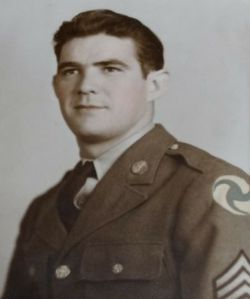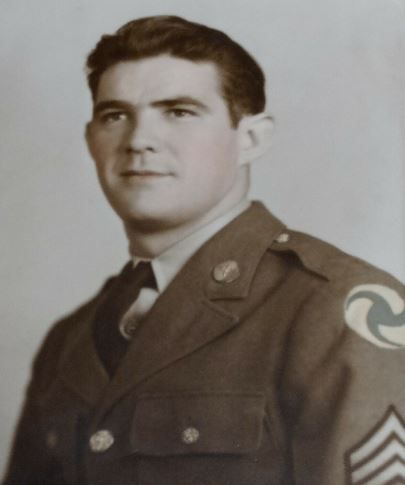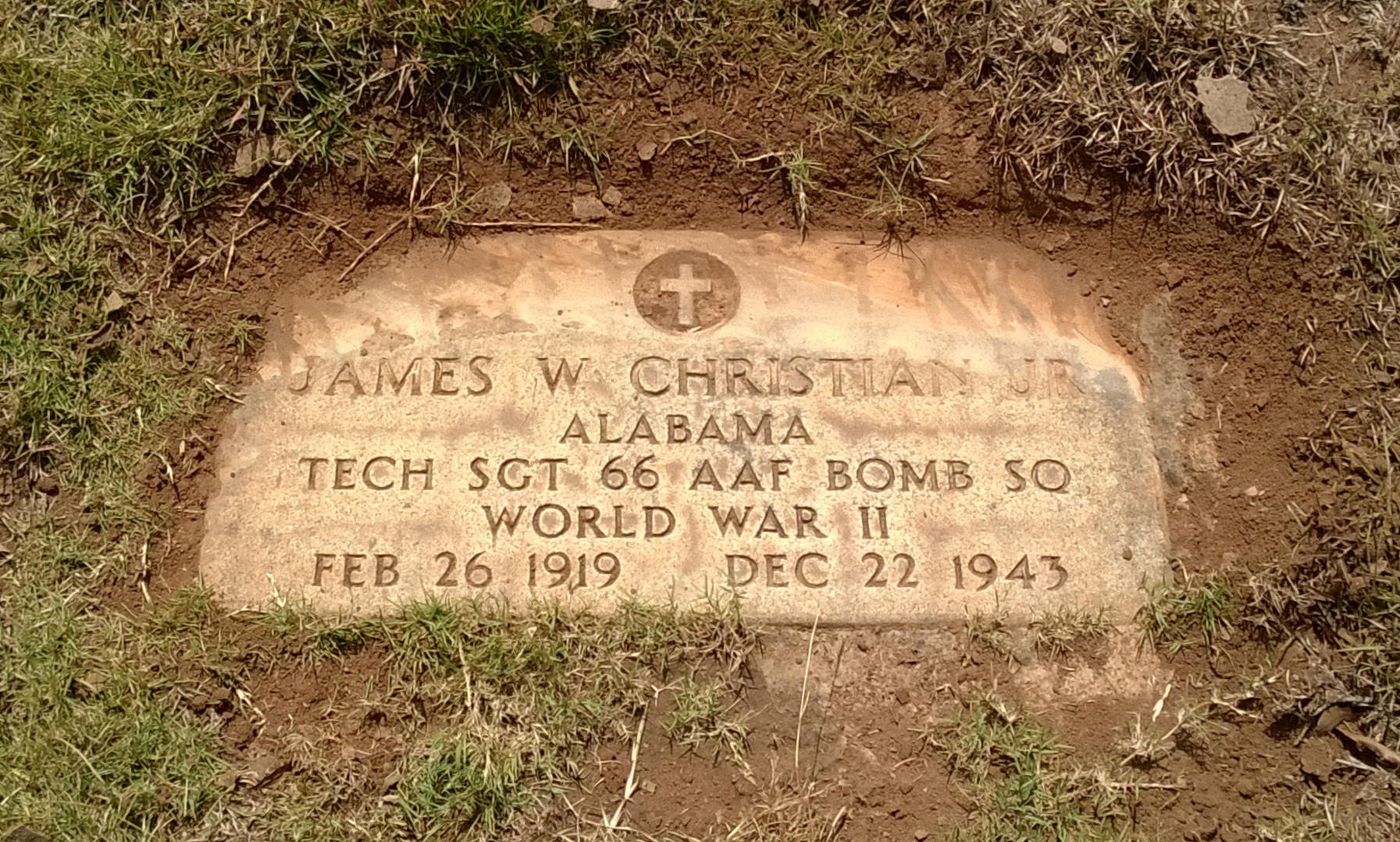Bombardier T/Sgt. James W. Christian Jr. KIA
Hometown: Seberling, Florida
Squadron: 66th 44th Bomb Group
Service# 4266875
Awards: Air Medal, Purple Heart
Pilot 1st/Lt. Warren W. Oakley KIA
MACR #1713
Target: Munster, Germany
Mission Date: 22-Dec-43
Serial Number: #42-7533
Aircraft Model B-24
Aircraft Letter:
Aircraft Name:
Location: Holland
Cause: flak fighters Crew of 10 7 KIA 3 POW
The weather on this mission was terrible, with heavy clouds up above 20,000 feet and thunderstorms as well as very low clouds over Holland. Bombing was done by PFF, with results unobserved. Flak was moderate but accurate, and the 44th BG lost two planes, both from the 66th Squadron.
The second 66th Squadron aircraft lost was piloted by 1st Lt. Warren W. Oakley and Richard K. Collins. The MACR contains this information: Aircraft #533 was reported as lagging in the rear of the formation just after target with bomb bay doors still open. Different crews observed this aircraft at various times between 1400 and 1431 hours and each one reported that it was losing altitude but apparently under control. Aircraft #548 (Heskett’s) had been flying on the right wing and Heskett reported that he pulled alongside #533 to determine why they were not keeping up with the formation. (It was later learned that #533 had lost three superchargers.) Oakley motioned for him to go ahead and catch the formation. At 1431, the tail gunner of #548, saw the ship begin to spiral down below into the clouds. It was not believed likely that any of the crew survived as no chutes were seen to open. A crew member, Sgt. Abel Fleischman, tells his account: “I was flying spare radio operator on this crew. First of all, we were hit by flak, and then jumped by about five to seven fighters. We couldn’t unload our bombs as they were stuck as were the bomb bay doors. Our bombardier, Christian, asked the pilot if he should unload them by hand, but the pilot said, ‘No. We are over enemy-occupied land.’
“The fighters knocked all or at least part of our tail off. After Byers (engineer) came out of the top turret and bailed out, I think we started to go into a spin, but I managed to get out as well. Just Byers and I got out. note: One more crewmember, Lt. Frank Powers, also got out.
“Miller’s crew also went down the same day – that was my original crew with whom I trained. I landed by parachute in Holland (near Den Ham). After hiding out a couple of hours, was captured and taken to a Dutch hospital for about six weeks. Then to Frankfurt, Stalag Luft 6, 4, and l.”
Lt. Frank D. Powers, navigator, adds, “We were a squadron leader and made our target. But we lost two engines on the return, our wingmen abandoned us, and flak or fighters hit the tail surfaces – and we spiraled down, out of control. T/Sgt. Christian, the bombardier, and I had no warning of how serious the problem was, so we stayed with the plane. (Pilots were so busy trying to regain control they couldn’t ring the bail out warning.) We thought that Warren Oakley would regain control. Byers and the radio operator (Fleischman) knew about the tail damage and they abandoned ship at high altitude. Had Byers warned us, we probably all would have made it. Christian, bless him, helped me put on my parachute and was killed by the jump. We were so low, less than 800 feet at that time, that Christian’s chute never fully opened.
“Before the local policemen arrived, a young man of about 25 or so, came up to me and in good English, said ‘I congratulate you – all of your friends are dead.’ At that time I did not know we were in the Netherlands and had the fleeting thought that he was a German and was going to inflict a terrible beating on me.
“Then a policeman, a young man about my age, 22, arrived and his sympathy was with me, but with the surrounding families knowing that I was there, he had to phone the German authorities and release me to them.”
I contacted the widow of John F. Byers, who gave me the following information: “John told me much of what Abel Fleishman told you. He also thought that they were the only two to get out. John was too big to wear his chute in the turret, so he grabbed it and snapped it on, but when he tried to pull the ripcord, he had it on upside down. In his own words, it scared the hell out of him, but as you know, it worked. He landed in a plowed field somewhere in Holland, went in to the top of his boots, and hurt his knee. Some men were there almost as soon as he landed – they helped him to a barn, then hid him in the hay, under gobs of hay. Soon S.S. men came with pitch forks, but he was hidden deep enough that they missed him. When they left, one of the Dutch men got him on a bicycle, took him in to town and to a doctor (Den Ham?). He stayed there over a Pub or bar until they could move him a few days later.”
John managed to avoid capture for a considerable period, had many close calls – too many to include in this report. Then an informer notified the S.S. and he was captured and became a POW.
P.C. Meijer, Dutch historian from Den Ham, Netherlands, has sent data about his investigation of this crew. “Last week I found the place where the Liberator came down, and met a farmer who lives near the place. The farmer, Mr. Bril, said he remembered all what happened, he was outdoors when the plane came in at low speed and was just above the roof of the barn. At first, he thought it was a belly landing, but it hit very hard. Then immediately, he saw an American come running toward him (Powers, who had just parachuted) and was yelling, ‘Bomb! Bomb!’ and making gestures to lie down – and he did. The aircraft exploded immediately and it was like a fireworks display with the ammunition exploding, fire, flares, etc. Pieces of the plane were strewn about. The explosions made a large crater seven meters deep and 20 meters in diameter, broke the windows in his house, and blew the doors open. “One crew member landed about 30 meters from his house – Powers. People later told him that another chutist, Fleischman, came down southwest of his farm, and he hid in the woods and was soon captured. And the third chutist, Byers, was found and hidden by the other farmers in the area. In a very short time, the Germans arrived to take Powers prisoner, but they could not understand English, so brought in a teacher who spoke English to interpret for them. Later, he was taken away...”
In 1985, during the 40th anniversary celebration of the liberation of their country, the people of Den Ham honored this crew with speeches, flowers, photographs – they are remembered!
#42-7533 Crew
1st/Lt. Warren W. Oakley Pilot
1st/Lt. Richard K. Collins Co Pilot KIA
Frank D. Powers Navigator POW
T/Sgt. James W. Christian Jr. Bombardier KIA
T/Sgt. John F. Byers Engineer POW
S/Sgt. Abel Fleischman Radio Op. POW
S/Sgt. Robert F. Smith Gunner KIA
S/Sgt. Arthur C. Timme Gunner KIA
S/Sgt. Lewis R. Weaver Gunner KIA
S/Sgt. Willis Sondag Gunner KIA
Bombardier T/Sgt. James W. Christian Jr. KIA
Hometown: Seberling, Florida
Squadron: 66th 44th Bomb Group
Service# 4266875
Awards: Air Medal, Purple Heart
Pilot 1st/Lt. Warren W. Oakley KIA
MACR #1713
Target: Munster, Germany
Mission Date: 22-Dec-43
Serial Number: #42-7533
Aircraft Model B-24
Aircraft Letter:
Aircraft Name:
Location: Holland
Cause: flak fighters Crew of 10 7 KIA 3 POW
The weather on this mission was terrible, with heavy clouds up above 20,000 feet and thunderstorms as well as very low clouds over Holland. Bombing was done by PFF, with results unobserved. Flak was moderate but accurate, and the 44th BG lost two planes, both from the 66th Squadron.
The second 66th Squadron aircraft lost was piloted by 1st Lt. Warren W. Oakley and Richard K. Collins. The MACR contains this information: Aircraft #533 was reported as lagging in the rear of the formation just after target with bomb bay doors still open. Different crews observed this aircraft at various times between 1400 and 1431 hours and each one reported that it was losing altitude but apparently under control. Aircraft #548 (Heskett’s) had been flying on the right wing and Heskett reported that he pulled alongside #533 to determine why they were not keeping up with the formation. (It was later learned that #533 had lost three superchargers.) Oakley motioned for him to go ahead and catch the formation. At 1431, the tail gunner of #548, saw the ship begin to spiral down below into the clouds. It was not believed likely that any of the crew survived as no chutes were seen to open. A crew member, Sgt. Abel Fleischman, tells his account: “I was flying spare radio operator on this crew. First of all, we were hit by flak, and then jumped by about five to seven fighters. We couldn’t unload our bombs as they were stuck as were the bomb bay doors. Our bombardier, Christian, asked the pilot if he should unload them by hand, but the pilot said, ‘No. We are over enemy-occupied land.’
“The fighters knocked all or at least part of our tail off. After Byers (engineer) came out of the top turret and bailed out, I think we started to go into a spin, but I managed to get out as well. Just Byers and I got out. note: One more crewmember, Lt. Frank Powers, also got out.
“Miller’s crew also went down the same day – that was my original crew with whom I trained. I landed by parachute in Holland (near Den Ham). After hiding out a couple of hours, was captured and taken to a Dutch hospital for about six weeks. Then to Frankfurt, Stalag Luft 6, 4, and l.”
Lt. Frank D. Powers, navigator, adds, “We were a squadron leader and made our target. But we lost two engines on the return, our wingmen abandoned us, and flak or fighters hit the tail surfaces – and we spiraled down, out of control. T/Sgt. Christian, the bombardier, and I had no warning of how serious the problem was, so we stayed with the plane. (Pilots were so busy trying to regain control they couldn’t ring the bail out warning.) We thought that Warren Oakley would regain control. Byers and the radio operator (Fleischman) knew about the tail damage and they abandoned ship at high altitude. Had Byers warned us, we probably all would have made it. Christian, bless him, helped me put on my parachute and was killed by the jump. We were so low, less than 800 feet at that time, that Christian’s chute never fully opened.
“Before the local policemen arrived, a young man of about 25 or so, came up to me and in good English, said ‘I congratulate you – all of your friends are dead.’ At that time I did not know we were in the Netherlands and had the fleeting thought that he was a German and was going to inflict a terrible beating on me.
“Then a policeman, a young man about my age, 22, arrived and his sympathy was with me, but with the surrounding families knowing that I was there, he had to phone the German authorities and release me to them.”
I contacted the widow of John F. Byers, who gave me the following information: “John told me much of what Abel Fleishman told you. He also thought that they were the only two to get out. John was too big to wear his chute in the turret, so he grabbed it and snapped it on, but when he tried to pull the ripcord, he had it on upside down. In his own words, it scared the hell out of him, but as you know, it worked. He landed in a plowed field somewhere in Holland, went in to the top of his boots, and hurt his knee. Some men were there almost as soon as he landed – they helped him to a barn, then hid him in the hay, under gobs of hay. Soon S.S. men came with pitch forks, but he was hidden deep enough that they missed him. When they left, one of the Dutch men got him on a bicycle, took him in to town and to a doctor (Den Ham?). He stayed there over a Pub or bar until they could move him a few days later.”
John managed to avoid capture for a considerable period, had many close calls – too many to include in this report. Then an informer notified the S.S. and he was captured and became a POW.
P.C. Meijer, Dutch historian from Den Ham, Netherlands, has sent data about his investigation of this crew. “Last week I found the place where the Liberator came down, and met a farmer who lives near the place. The farmer, Mr. Bril, said he remembered all what happened, he was outdoors when the plane came in at low speed and was just above the roof of the barn. At first, he thought it was a belly landing, but it hit very hard. Then immediately, he saw an American come running toward him (Powers, who had just parachuted) and was yelling, ‘Bomb! Bomb!’ and making gestures to lie down – and he did. The aircraft exploded immediately and it was like a fireworks display with the ammunition exploding, fire, flares, etc. Pieces of the plane were strewn about. The explosions made a large crater seven meters deep and 20 meters in diameter, broke the windows in his house, and blew the doors open. “One crew member landed about 30 meters from his house – Powers. People later told him that another chutist, Fleischman, came down southwest of his farm, and he hid in the woods and was soon captured. And the third chutist, Byers, was found and hidden by the other farmers in the area. In a very short time, the Germans arrived to take Powers prisoner, but they could not understand English, so brought in a teacher who spoke English to interpret for them. Later, he was taken away...”
In 1985, during the 40th anniversary celebration of the liberation of their country, the people of Den Ham honored this crew with speeches, flowers, photographs – they are remembered!
#42-7533 Crew
1st/Lt. Warren W. Oakley Pilot
1st/Lt. Richard K. Collins Co Pilot KIA
Frank D. Powers Navigator POW
T/Sgt. James W. Christian Jr. Bombardier KIA
T/Sgt. John F. Byers Engineer POW
S/Sgt. Abel Fleischman Radio Op. POW
S/Sgt. Robert F. Smith Gunner KIA
S/Sgt. Arthur C. Timme Gunner KIA
S/Sgt. Lewis R. Weaver Gunner KIA
S/Sgt. Willis Sondag Gunner KIA
Family Members
Sponsored by Ancestry
Advertisement
Records on Ancestry
Advertisement













